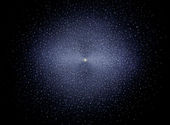
© High-Z Supernova Search Team, HST, NASACosmologists use Type Ia supernovae, like the one visible in the lower left corner of this galaxy, to explore the past and future expansion of the universe and the nature of dark energy.
An international team led by Yale University has, for the first time, measured the mass of a type of supernova thought to belong to a unique subclass and confirmed that it surpasses what was believed to be an upper mass limit. Their findings, which appear online and will be published in an upcoming issue of the
Astrophysical Journal, could affect the way cosmologists measure the expansion of the universe.
Cosmologists use Type Ia supernovae-the violent explosions of dead cores of stars called white dwarfs-as a kind of cosmic ruler to measure distances to the supernovae's host galaxies and, as such, to understand the past and future expansion of the universe and explore the nature of dark energy.
Until recently, it was thought that white dwarfs could not exceed what is known as the Chandrasekhar limit, a critical mass
equaling about 1.4 times that of the Sun, before exploding in a supernova. This uniform limit is a key tool in measuring distances to supernovae.
Since 2003, four supernovae have been discovered that were so bright, cosmologists wondered whether their white dwarfs had surpassed the Chandrasekhar limit. These supernovae have been dubbed the "super-Chandrasekhar" supernovae.






Comment: Yes everyone, keep calm. Another article of of the "Relax! Anything bad that might happen to the Big Blue Marble is a long way off'." variety.
Perhaps not? Meteorites, Asteroids, and Comets: Damages, Disasters, Injuries, Deaths, and Very Close Calls